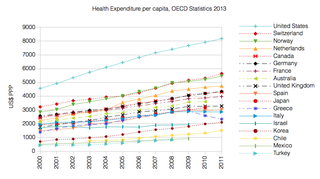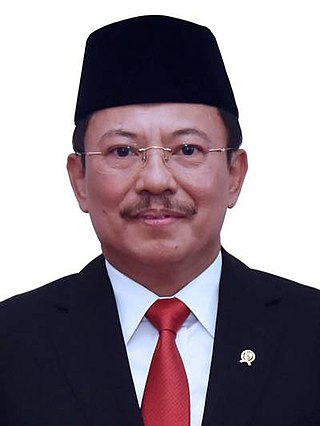
Government expenditure on healthcare was about 3.1% of its total gross domestic product in 2018. [1]

Government expenditure on healthcare was about 3.1% of its total gross domestic product in 2018. [1]

As of 2019, there are 2,813 hospitals in Indonesia, 63.5% of which are run by private organisations. [2] In 2012, according to data from the Ministry of Health of Indonesia, there were 2,454 hospitals around the country, with a total of 305,242 beds, a figure of 0.9 bed per 1,000 inhabitants. Most hospitals are in urban areas. [3] [4] According to the 2012 World Bank data, there are 0.2 physicians per 1,000 people, with 1.2 nurses and midwives per 1,000 people in Indonesia. [4] Out of all the 2,454 hospitals in Indonesia, 20 have been accredited by Joint Commission International (JCI) as of 2015. [5] In addition, there are 9,718 government-financed Puskesmas (Health Community Centre) listed by the Ministry of Health of Indonesia, which provide comprehensive healthcare and vaccination for the population in the sub-district level. Both traditional and modern health practices are employed.
Indonesia's community health system is organised in three tiers: on top of the chart is Community Health Centre (Puskesmas), followed by Health Sub-Centres on the second level, and Village-Level Integrated Posts at the third level. [6]

In 2010, an estimated 56% of Indonesians, mainly state employees, low-income earners, and those with private coverage had some form of health insurance. The rate was expected to reach 100% by 2019, following the implementation of a system of universal social health insurance coverage that was launched in 2014. As of 2020, an estimated 83% of the population (223 million people) were covered by the scheme. [7] The aim was to grant free services for all hospitalisations in basic (class-3) hospital beds. [8]
Healthcare provision in Indonesia has traditionally been fragmented, with private insurance being provided for those who can afford it alongside basic public coverage for the most impoverished in society and NGOs working in specialised areas providing services to those not covered by public or private schemes. In January 2014, the government launched Jaminan Kesehatan Nasional (JKN, "National Health Insurance"), a scheme to implement universal health care. It was expected that spending on healthcare would increase by 12% a year and reach US$46 billion a year by 2019. [9] [ needs update ]
Under JKN, all Indonesians will receive coverage for a range of treatments via health services from public providers as well as those private organisations that have opted to join the scheme. The formally employed pay a premium worth 5% of their salary, with 1% being paid by the employee and 4% being paid by their employer. Informal workers and the self-employed pay a fixed monthly premium of between 25,500 and 59,500 IDR (£1.34-£3.12). However, the scheme has been criticised for being over-ambitious, a lack of competency in administration, and a failure to address the need for improving healthcare infrastructure in remote areas. An official for the programme's administering organisation, the social security agency BPJS Kesehatan, has stated that JKN exceeded its target for enrolling members in its first year (registering 133.4 million members compared to a target of 121.6 million) and that, according to an independent survey, the customer satisfaction rate was 81%, awareness of JKN was 95%, and that complaints had been resolved within one and a half days on average. JKN is expected to be implemented in stages. When the initial stages came into effect in January 2014, 48% of the country's population became covered. As of April 2018, the scheme had 195 million enrollees (75% of the population). [10] It is expected that the entire population will be covered in 2019. [11] [12]
In 2016, the BPJS program had a deficit of more than IDR six trillion. However, the deficit ballooned to 32 trillion in only three years. [13] In response, the government issued a policy that increases the monthly premium for access by 80 to 100%. Some saw the move as placing a burden on the low- and middle-income citizens. [14] [15] [16]

Eleven per cent of the country's population suffers from mental disorders, [17] with over 19 million of the people of age 15 or older. [18] The neuropsychiatric disorders in Indonesia are estimated to contribute to 10.7% of the burden disease. [19] There are definitely gaps in the mental health department that cannot be overlooked, with many of them are representative of the mental health gaps in Southeast Asia as a whole. The mental health policy in Indonesia was most recently revised in 2001. Since then, the nation has gone through enormous changes in all aspects as a country. Indonesia's economy has been steadily growing in the past decade. Health wise, Indonesia has suffered numerous H5N1 outbreaks, with the highest number of recorded human cases of this virus in the world. [20] The nation was severely affected by the tsunami tragedy in 2004. There are still many factors that have altered Indonesians' lives, ultimately affecting the mental health status of the people significantly since 2001, calling for a more updated mental health policy.
There is a tiny amount of funding dedicated to mental health. The total health expenditure is 2.36%, and less than 1% of that goes towards mental health. [19] Indonesia's mental health legislation has the same issues mentioned above that Southeast Asia faces as a region. The law is far from what can be considered complete and fair, and the articles included are not well practised and reinforced. In 1966, Indonesia was well ahead of other countries in the region by having a mental health law separated from general health laws, providing potentials for expansion of the mental health system. However, the law was repealed in 1993 and integrated into general health laws. [21] Mental health now only occupies four articles in the current health law. [22] The articles are too broad, causing difficulties of application and implementation. Article 26 states that almost anybody can request treatment and hospitalisation for persons with a mental disorder, yet has no mention of the person's consent. By doing so, Article 26 creates an impression that mentally ill individuals are generally considered dangerous to the community because they need to be forced into treatment. [22] This situation goes along with the negative stigmas associated with mental disorders. Also, Article 27 states that the government would provide a presidential decree for regulations and management of mental health, yet nothing has been done. [22]
There are also issues with accessibility and quality of mental health care. Official in-service training is not widely provided to primary care professionals. WHO reports in 2011 that between 2006 and 2011, the majority of primary care doctors and nurses have not received such training. There is also only one mental health hospital per five million people and one psychiatrist working in the mental health sector in ten million people. [19] In addition to the unbalanced number of psychiatrists among the population, the psychiatrists are also not well distributed in the country. Up until 2011, there were no psychiatrists in rural areas, while half of them are concentrated in the capital city of Jakarta, and the rest in Yogyakarta, and the second-largest city, Surabaya. [23] This situation creates a barrier for mental health patients seeking official help.

Health care, or healthcare, is the improvement of health via the prevention, diagnosis, treatment, amelioration or cure of disease, illness, injury, and other physical and mental impairments in people. Health care is delivered by health professionals and allied health fields. Medicine, dentistry, pharmacy, midwifery, nursing, optometry, audiology, psychology, occupational therapy, physical therapy, athletic training, and other health professions all constitute health care. The term includes work done in providing primary care, secondary care, tertiary care, and public health.

Ternate, also known as the City of Ternate, is a city in the Indonesian province of North Maluku and an island in the Maluku Islands. It was the de facto provincial capital of North Maluku before Sofifi on the nearby coast of Halmahera became the capital in 2010. It is off the west coast of Halmahera, and is composed of five islands: Ternate, the biggest and main island of the city, and Moti, Hiri, Tifure and Mayau. In total, the city has a land area of 162.20 square kilometres and had a total population of 185,705 according to the 2010 census, and 205,001 according to the 2020 census, with a density of 1,264 people per square kilometre; the official estimate as at mid 2023 was 204,920. It is the biggest and most densely populated city in the province, as well as the economic, cultural, and education center of North Maluku, and acts as a hub to neighbouring regions. It was the capital of the Sultanate of Ternate in the 15th and 16th centuries, and fought against the Sultanate of Tidore over control of the spice trade in the Moluccas before becoming a main interest to competing European powers.

Switzerland has universal health care, regulated by the Swiss Federal Law on Health Insurance. There are no free state-provided health services, but private health insurance is compulsory for all persons residing in Switzerland.
National health insurance (NHI), sometimes called statutory health insurance (SHI), is a system of health insurance that insures a national population against the costs of health care. It may be administered by the public sector, the private sector, or a combination of both. Funding mechanisms vary with the particular program and country. National or statutory health insurance does not equate to government-run or government-financed health care, but is usually established by national legislation. In some countries, such as Australia's Medicare system, the UK's National Health Service and South Korea's National Health Insurance Service, contributions to the system are made via general taxation and therefore are not optional even though use of the health system it finances is. In practice, most people paying for NHI will join it. Where an NHI involves a choice of multiple insurance funds, the rates of contributions may vary and the person has to choose which insurance fund to belong to.

The healthcare delivery system of Pakistan is complex because it includes healthcare subsystems by federal governments and provincial governments competing with formal and informal private sector healthcare systems. Healthcare is delivered mainly through vertically managed disease-specific mechanisms. The different institutions that are responsible for this include: provincial and district health departments, parastatal organizations, social security institutions, non-governmental organizations (NGOs) and private sector. The country's health sector is also marked by urban-rural disparities in healthcare delivery and an imbalance in the health workforce, with insufficient health managers, nurses, paramedics and skilled birth attendants in the peripheral areas. Pakistan's gross national income per capita in 2021 was $4,990 and the total expenditure on health per capita in 2021 was Rs 657.2 Billion, constituting 1.4% of the country's GDP. The health care delivery system in Pakistan consists of public and private sectors. Under the constitution, health is primarily responsibility of the provincial government, except in the federally administered areas. Health care delivery has traditionally been jointly administered by the federal and provincial governments with districts mainly responsible for implementation. Service delivery is being organized through preventive, promotive, curative and rehabilitative services. The curative and rehabilitative services are being provided mainly at the secondary and tertiary care facilities. Preventive and promotive services, on the other hand, are mainly provided through various national programs; and community health workers’ interfacing with the communities through primary healthcare facilities and outreach activities. The state provides healthcare through a three-tiered healthcare delivery system and a range of public health interventions. Some government/ semi government organizations like the armed forces, Sui Gas, WAPDA, Railways, Fauji Foundation, Employees Social Security Institution and NUST provide health service to their employees and their dependants through their own system, however, these collectively cover about 10% of the population. The private health sector constitutes a diverse group of doctors, nurses, pharmacists, traditional healers, drug vendors, as well as laboratory technicians, shopkeepers and unqualified practitioners.

Healthcare in Mexico is a multifaceted system comprising public institutions overseen by government departments, private hospitals and clinics, and private physicians. It is distinguished by a unique amalgamation of coverage predominantly contingent upon individuals' employment statuses. Rooted in the Mexican constitution's principles, every Mexican citizen is entitled to cost-free access to healthcare and medication. This constitutional mandate is translated into reality through the auspices of the "Institute of Health for Well-being," abbreviated as INSABI. INSABI does not exist anymore.
Health in Indonesia is affected by a number of factors. Indonesia has over 26,000 health care facilities; 2,000 hospitals, 9,000 community health centres and private clinics, 1,100 dentist clinics and 1,000 opticians. The country lacks doctors with only 0.4 doctors per 1,000 population. In 2018, Indonesia's healthcare spending was US$38.3 billion, 4.18% of their GDP, and is expected to rise to US$51 billion in 2020.

Hungary has a tax-funded universal healthcare system, organized by the state-owned National Health Insurance Fund. While healthcare is considered universal, several reasons persist preventing Hungarian nationals to access healthcare services. For instance, a Hungarian citizen who lived abroad but is unable to show contributions to another country's healthcare system will not be able to access the Hungarian healthcare system free of charge. However, to the OECD, 100% of the total population is covered by universal health insurance, which is absolutely free for children, mothers or fathers with babies, students, pensioners, people with low income, handicapped people, priests and other church employees. In 2022 the cost of public health insurance is 8,400 HUF per month which is the equivalent of $23.69. The healthcare system underwent significant changes which also resulted in improving life expectancy and a very low infant mortality rate. According to the OECD Hungary spent 7.8% of its GDP on health care in 2012. Total health expenditure was $US1,688.7 per capita in 2011, US$1,098.3governmental-fund (65%) and US$590.4 private-fund (35%).

A healthcare center, health center, or community health center is one of a network of clinics staffed by a group of general practitioners and nurses providing healthcare services to people in a certain area. Typical services covered are family practice and dental care, but some clinics have expanded greatly and can include internal medicine, pediatric, women’s care, family planning, pharmacy, optometry, laboratory testing, and more. In countries with universal healthcare, most people use the healthcare centers. In countries without universal healthcare, the clients include the uninsured, underinsured, low-income or those living in areas where little access to primary health care is available. In the Central and East Europe, bigger health centers are commonly called policlinics.

Rashtriya Swasthya Bima Yojana is a government-run health insurance programme for the Indian poor. The scheme aims to provide health insurance coverage to the unrecognised sector workers belonging to the BPL category and their family members shall be beneficiaries under this scheme. It provides for cashless insurance for hospitalisation in public as well as private hospitals. The scheme started enrolling on April 1, 2008 and has been implemented in 25 states of India. A total of 36 million families have been enrolled as of February 2014. Initially, RSBY was a project under the Ministry of Labour and Employment. Now it has been transferred to Ministry of Health and Family Welfare from April 1, 2015
Examples of health care systems of the world, sorted by continent, are as follows.

Tanjung Selor is the capital of both the North Kalimantan province in Indonesia, and of the Bulungan Regency. It is among provincial capitals in Indonesia that as of 2021 does not yet have city status, together with Mamuju in West Sulawesi, Sofifi in North Maluku, Wanggar in Central Papua, Wamena in Highland Papua, Salor in South Papua, and Manokwari in West Papua. The district has an area of 677.77 km2 and had a population of 39,439 at the 2010 Census and 56,569 at the 2020 Census; the official estimate as at mid 2023 was 63,588.

The Pusat Kesehatan Masyarakat, abbreviated as Puskesmas, are government-mandated community health clinics located across Indonesia. They are overseen by the Indonesian Ministry of Health and provide healthcare for the population on sub-district level. The concept was designed by Johannes Leimena, the third Indonesian Minister of Health, and was realized by G. A. Siwabessy in New Order era. Community and preventive health programs formed another component of Indonesia's health system. There are 9,719 Puskesmas facilities around the country according to the Ministry of Health report in 2014; all are regarded as "first-level health facilities" by the national healthcare provider BPJS Kesehatan.

Dr. Nova Riyanti Yusuf, SpKJ (psychiatrist) born in Palu, Central Sulawesi, was an Indonesian author. Nova often calls herself NoRiYu. Nova was a member of the House of Representatives as a representative of the Democratic Party for the 2009 - 2014 and 2014–2019 period. During her term as a representative, she initiated and supported the Mental Health Law. The bill was passed into Law in 2014.

Terawan Agus Putranto is an Indonesian physician who served as the Minister of Health of Indonesia between 23 October 2019 and 23 December 2020. He graduated from the Faculty of Medicine of Gajah Mada University and then joined the Indonesian Army as a military physician. Afterwards he studied Radiology in Airlangga University and obtained his doctoral degree in Hasanuddin University at 2013. He is a radiologist. He is the fourth Health Minister of Indonesia to have come from the military and the first since Suwardjono Surjaningrat, who was in office between 1978 and 1988. As Suwardjono and the two earlier officers were 2-star generals, Terawan, a 3-star general, is the highest-ranked military officer to have ever held this ministerial office.

Putih Sari is an Indonesian politician and legislator. She became a member of the Indonesian Parliament for the Gerindra Party in the national electoral district West Java VII. She was part of Commission IX of the DPR.
Badan Penyelenggara Jaminan Sosial Kesehatan is a social security agency of Indonesia aimed at providing universal health care to its citizens. BPJS Kesehatan is one of two social security agencies in the country alongside BPJS Ketenagakerjaan.

Mental healthcare in India is a right secured to every person in the country by law. Indian mental health legislation, as per a 2017 study, meets 68% (119/175) of the World Health Organization (WHO) standards laid down in the WHO Checklist of Mental Health Legislation. However, human resources and expertise in the field of mental health in India is significantly low when compared to the population of the country. The allocation of the national healthcare budget to mental health is also low, standing at 0.16%. India's mental health policy was released in 2014.

Tigor Silaban was an Indonesian doctor.